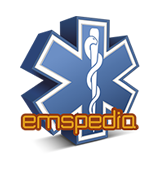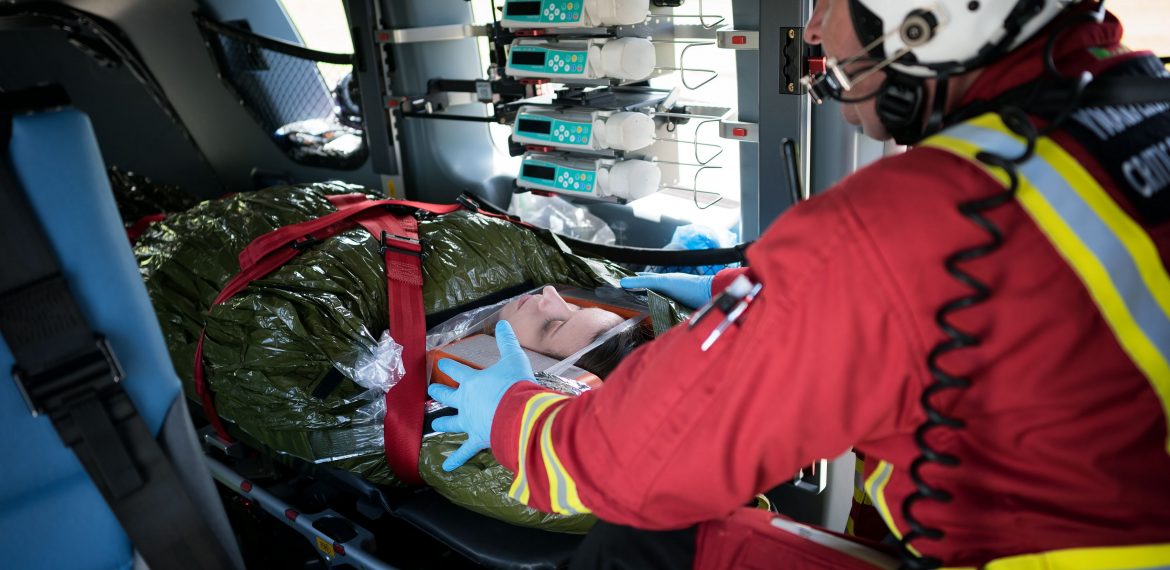The importance of air ambulance helicopters is well known however, it is rare hearing about a paediatric flying ambulance that only takes care of little patients. Well, this kind of rescue helicopter does really exist! It is The Children’s Wales Air Ambulance Service.
Our curiosity has grown and we started wondering how might be taking care of paediatric patients on board a helicopter, and the importance of having the right means to do this. So we talked with Mr Mark Winter Service Manager of Children’s Wales Air Ambulance Service who answered our questions.
- Can you describe what are the main interventions you are performing?
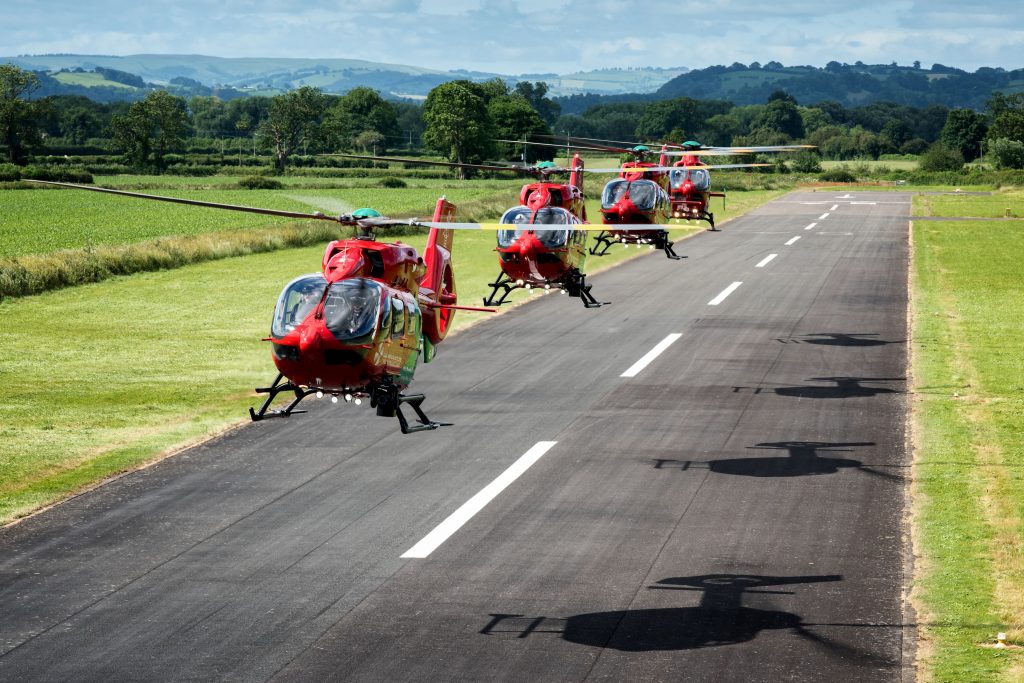 “We have two types of paediatric support and provision. We’ve got those that are life-threatening emergency calls that we would go out to as a primary helicopter Emergency Medical Response. Then we’ve got those patients who we are transporting between hospital facilities and who need specialist care from either a neonatal unit or specialist paediatric services. We have two different types of aircraft. We have an H145 Airbus helicopter which has a larger airframe, and we use it for our emergency work. Then, when we’re transporting our children around from one hospital to another, we’re utilizing an H135 Airbus helicopter that can be fitted with a special incubator. It’s an electronic medical device and we can put the baby inside the helicopters as if we were in a neonatal unit of a hospital. Then we’ve got another type of incubator that we can put a slightly larger child into or we can convey children on a standard stretcher who don’t need any extra sort of incubator support but do need to be looked after, kept warm and perhaps have some medication and fluids running. That’s the difference in the two types of treatment and transport that we provide to our smallest patients.”
“We have two types of paediatric support and provision. We’ve got those that are life-threatening emergency calls that we would go out to as a primary helicopter Emergency Medical Response. Then we’ve got those patients who we are transporting between hospital facilities and who need specialist care from either a neonatal unit or specialist paediatric services. We have two different types of aircraft. We have an H145 Airbus helicopter which has a larger airframe, and we use it for our emergency work. Then, when we’re transporting our children around from one hospital to another, we’re utilizing an H135 Airbus helicopter that can be fitted with a special incubator. It’s an electronic medical device and we can put the baby inside the helicopters as if we were in a neonatal unit of a hospital. Then we’ve got another type of incubator that we can put a slightly larger child into or we can convey children on a standard stretcher who don’t need any extra sort of incubator support but do need to be looked after, kept warm and perhaps have some medication and fluids running. That’s the difference in the two types of treatment and transport that we provide to our smallest patients.”
- WAA operates on a large area, from Pembrokeshire to Cardiff or the Snowdonia Park. What characteristics do you need to face so different environments?
“Those environments are totally different in their makeup and behaviour. We have rural areas that don’t have main artery motorway roads. We have urban areas, types of conurbations of people and buildings, and we also have really sparsely populated areas, such as the gorgeous mountains of Snowdonia and North Wales where mountain flying is a totally different thing to your normal flying. So, we have to take all of those features into account and weather in Wales can be at times very challenging. It can be very wet because we’re very near the coast or if we’re in the mountains it can be also very cold, and we might see like in Italy, where there is snow on the hills, but actually, it’s quite warm on the ground, a few thousand feet down. We have to be prepared to be able to work with these different areas and our pilots are specifically trained to do this. Many of our pilots are ex-military pilots who are used to working in these sorts of terrains and can offer a certain experience of having done so before. But also, we work on the beaches. We don’t have winches or our operations, specific search, and rescue aircraft for that, but we can go and work on beaches, pick up patients from the sand and take them to the hospital so we have to think about all of those things when we’re engaging in flying. Weather is important, also temperature because we don’t want ice, of course. We’ve got to have good visibility so that we can see where we’re going, using our navigation aids and our night vision goggles to help support us in that journey.”
- Who are the emergency operators onboard? who composes air ambulance’s crew, generally.
“In Wales, we have a consultant doctor whose background will either be emergency medicine or
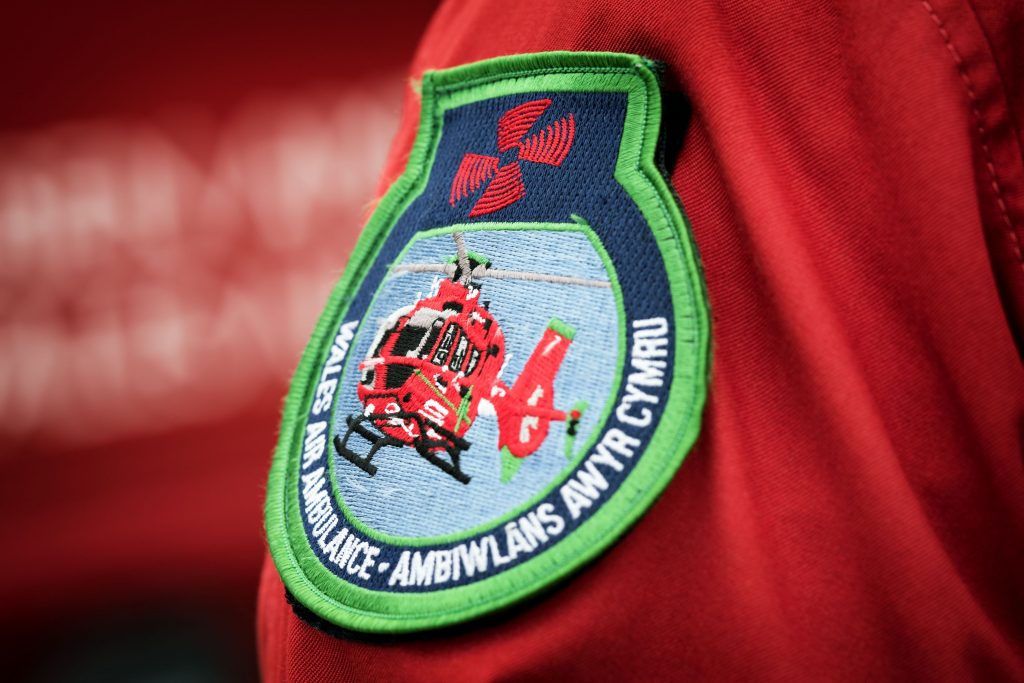
anaesthetic intensive care. Working alongside that doctor we will have a practitioner that’s either from a paramedic or nursing background and collectively they work together as a team of two. Then, they have a pilot that obviously flies the aircraft and looks after that element but the special thing about the role of a paramedic or nurse HEMS aircraft member is they also support the pilot in their duties. They will do what was determined a helicopter technical crew members course. For two weeks they’ll learn about aviation navigation, care in the air, making sure that we’re operating safely, fueling the helicopter so they take on a bit of a double role. They’re not just a paramedic or a nurse, they’re also somebody who can support the doctor and the pilots very much important as well.”
- How many interventions do you realize every year and what are your range and the time of your operation?
“In the last year, from an emergency perspective, we undertook just short of 2,700 calls. That works out about 7 or 8 calls a day. We operate on seven days a week. We are not currently working 24/7, but we hope to be in the not-too-distant future. If we took the children specifically, they attribute about 17% of our overall workload. We would do about 456 roughly speaking of those calls a year involving children and that would work out at least one, possibly one and a half, a day. Not that you can have half a person, of course, but that’s just how it goes. More importantly, what we found is that our range of patients are going from newborns through to a hundred years of age, we are dealing with a case-mix which is 32% female and 68% male and importantly we bring certain skills and expertise to the roadside or at the home and we take those skills away from the hospital out to the community. In that time frame, we provided anaesthetics to 160 people and gave blood and blood products over a hundred occasions in the pre-hospital environment. We’re using some very critical interventions to care for our sickest patients.”
- Helicopter EMS usually is created for performing as soon as possible the stabilization of the patient. Could you tell us what are the innovations and the devices that are improving your way of performing ALS?
“There’s a multitude of things that we can do in the pre-hospital arena to make it better for patients 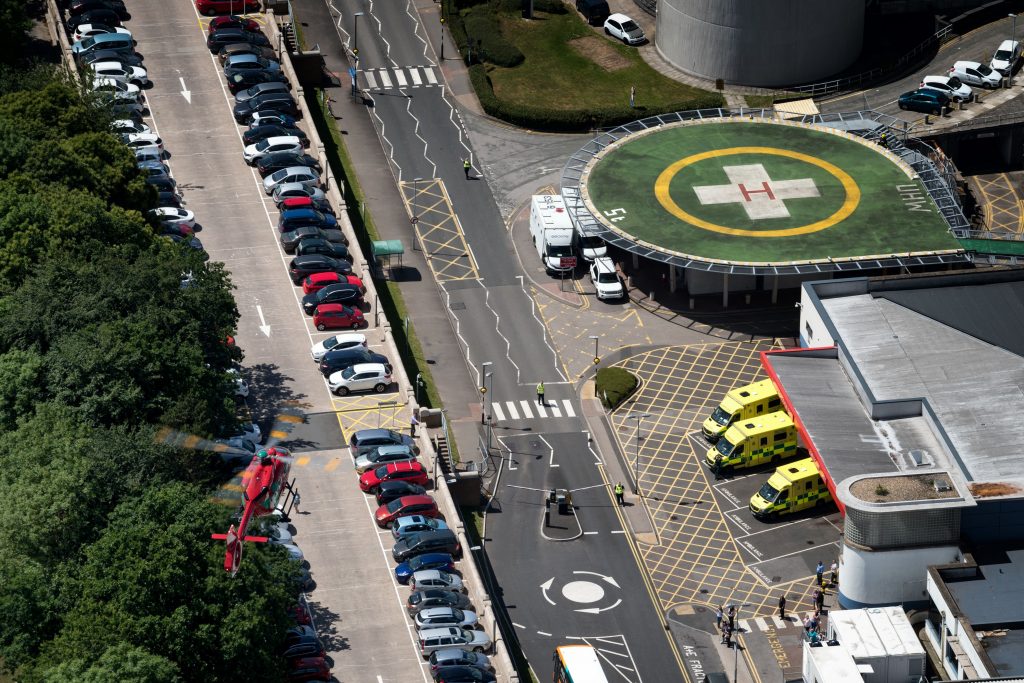 who are critically unwell: good training, good education, learning all the time from colleagues around us, and being up-to-date with all the principles and practices that provide such an important care pathway to this group of patients. We can utilize the medical device with the utmost quality, that is absolutely reliable to us is very important; really good ventilators, having heart monitors and general vital signs monitors available on helicopters are fundamental. The ability to look at a patient not only as an individual but taking blood gases and using technology in order to streamline our treatment and our medications toward what the patients need. We have to treat patients as if they were in the hospital. Advanced decision-making onboard we’re got good critical care activity, nurses and paramedics are trained to be able to work with this equipment and provide the best possible enhancements for patients who need that care. We can bring an ultrasound to the side of the patient. We can bring blood. I mentioned earlier on we can stabilize very quickly patients who are descending, and then we can bring them back to a place of safety, where they can be looked after and have further care given to them once they’re in the hospital. “
who are critically unwell: good training, good education, learning all the time from colleagues around us, and being up-to-date with all the principles and practices that provide such an important care pathway to this group of patients. We can utilize the medical device with the utmost quality, that is absolutely reliable to us is very important; really good ventilators, having heart monitors and general vital signs monitors available on helicopters are fundamental. The ability to look at a patient not only as an individual but taking blood gases and using technology in order to streamline our treatment and our medications toward what the patients need. We have to treat patients as if they were in the hospital. Advanced decision-making onboard we’re got good critical care activity, nurses and paramedics are trained to be able to work with this equipment and provide the best possible enhancements for patients who need that care. We can bring an ultrasound to the side of the patient. We can bring blood. I mentioned earlier on we can stabilize very quickly patients who are descending, and then we can bring them back to a place of safety, where they can be looked after and have further care given to them once they’re in the hospital. “
- As we can imagine, there are 2 different settings between adult and paediatric air ambulance transportation: Why do you choose to operate paediatrics with an H135 and adults with H145?
“There are a group of patients who will go on the H145 as standard. If we’re doing practical inter-hospital transfers of patients who need the electronic incubator we’ve got an aircraft platform.
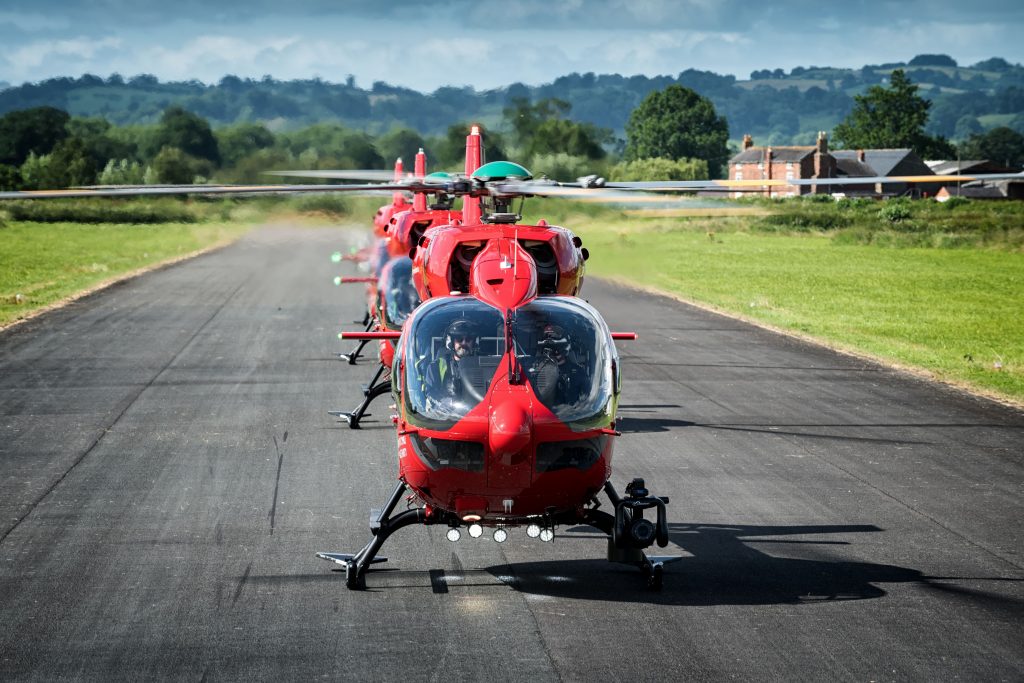
We’re still going through a bit of a review process about what is the best type of helicopter. Undoubtedly, being slightly smaller it means that we can’t take as much equipment, but we tend to take the patients in the H135 who are more settled and more stable. Actually, care interventions are slightly less than those from a pre-hospital primary emergency response type. A child knocked down in the street by a car, who’s got a head injury, we’ll need the bigger platform on the H145 to deal with that patient needs. However, when a patient who’s just going from one incubator bed to another and they need some basic support with their respiratory effort, we can do that with the equipment; and the space in the H135. Eventually, we hope to have a bigger aircraft but ware a charity and we have to have the public support in order to get us the funding to make these changes happen. Upgrading an H135 to an H145 it’s quite an expensive leap, so we have to get the money in from the charity from the public and then we can start to think about a bigger platform. But Children’s Wales Air Ambulance is a vital part of our operation, and we could do most things with the H135 that we could do the H145.”
- Let us be more specific on the devices: why is it so important to rescue an infant or a child with a dedicated device? Why don’t use or adapt an adult device, for example in paediatric patients?
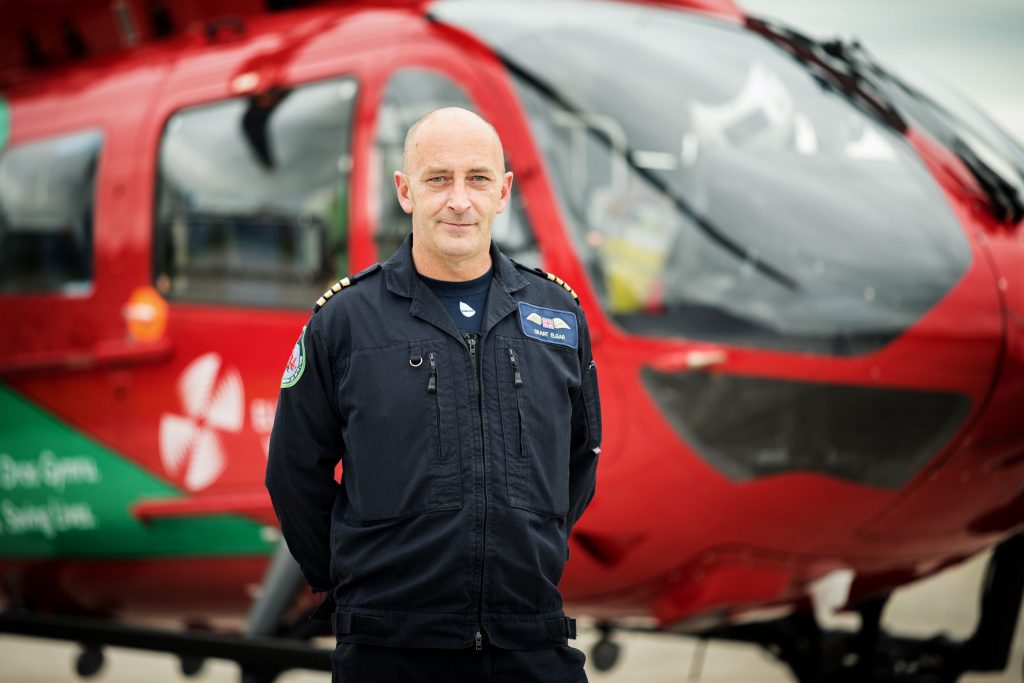 “The difference is that although children are little adults, they anatomically are different and therefore we have to cater for them not only from a medical point of view but also from a patient positioning point of view. If you lay a child down and don’t support their head properly, you could actually close off their airway, because they’re still in the formation of growing and their bones are developing so we have to make sure that we’re looking after them in a slightly different way. Because children are smaller, and equipment has to be tailored to their needs. They’re still developing with their lungs, all the different systems in their body, and therefore we have to make sure that our equipment matches what their body actually needs. What we don’t want to do – for example – is apply an incorrect ventilation strategy and then find that we are over-inflating their lungs. That means we have to use fine-tooled ventilator equipment to make sure that we’re looking after them. Equally, when it comes to the safety of transportation, we’ve got to make sure that children are looked after the same as if they were going into a car. That means you have to strap in them adequately. They’d probably be in a car seat, we can put them into an incubator. All of this equipment can be firmly placed into the aircraft and looked after and locked in. In the event there was to be a bit of rough landing or something like that, they’re not going to go anywhere, they’re going to be nice and safe, and protected in their environment.”
“The difference is that although children are little adults, they anatomically are different and therefore we have to cater for them not only from a medical point of view but also from a patient positioning point of view. If you lay a child down and don’t support their head properly, you could actually close off their airway, because they’re still in the formation of growing and their bones are developing so we have to make sure that we’re looking after them in a slightly different way. Because children are smaller, and equipment has to be tailored to their needs. They’re still developing with their lungs, all the different systems in their body, and therefore we have to make sure that our equipment matches what their body actually needs. What we don’t want to do – for example – is apply an incorrect ventilation strategy and then find that we are over-inflating their lungs. That means we have to use fine-tooled ventilator equipment to make sure that we’re looking after them. Equally, when it comes to the safety of transportation, we’ve got to make sure that children are looked after the same as if they were going into a car. That means you have to strap in them adequately. They’d probably be in a car seat, we can put them into an incubator. All of this equipment can be firmly placed into the aircraft and looked after and locked in. In the event there was to be a bit of rough landing or something like that, they’re not going to go anywhere, they’re going to be nice and safe, and protected in their environment.”
- Transporting an ICU team to the patient means also to have a direct link with the Hospital. What kind of data about the patient you can share actually with the operating room in the hospital?
“We tend to provide information about patients’ conditions between clinicians using radio or telephony as a standard practice. We have software we’re developing at the moment so that we’ll be able to send vital signs recordings from the aircraft whilst en route to the hospital. Bearing in mind, we do have advanced clinical decision-making onboard. We’ve got people who can diagnose and treat certain conditions so what it does allow us to do is to provide direct access to specialist services at the hospital. We can pass through information and vital signs and clinical information of the patient if we need to go straight to a heart attack centre. If we need to go to a lab in order to get the patient’s arteries to reopen than we can do that or we could go straight to a scanner rather than go via the emergency room first. We can do that because we have advanced decision-making, but we know there is further work that we want to do. For that now, our aircraft can use 4G technology in-flight and we can pass the information through the internet through to the hospital in a secure way. The receiving hospital so can see it and there’s a lot of work going on at the moment. More importantly, with our equipment, we pull off trends and patient clinical information when we arrive at the hospital and we share it with the team. They have got a history of the patient from our perspective and the time that we’ve been with them and the monitoring has been on. Having that is crucial, especially when we come to do our follow-ups with our data linkage and our monthly Clinical Governance Days. The analysis allows us to make sure that we get the right treatment for the next patient. We’ve got to review what we did with the last patient. It’s imperative.”
- In your experience, what are actually the main interesting developments for critical care?
“I think that critical care is being able to provide the most up-to-date medicine arrangements in  conjunction with other issues such as blood products in the pre-hospital arena. For us, having that level of care available allows us an excellent chance of stabilizing our most unwell patients. For so many years we’ve carried fluids like salty water, but they don’t carry all the nutrients, goodness, the oxygen, and the carbon dioxide in and around the body. This way we can actually provide that really good stabilization for the blood system at the source. I believe that it’s also the decision-making and making sure that patients are getting the sign to the right place first. Now, we can cut out a lot of time wasted, by going to somewhere we need to, then take them somewhere else. So we are reducing the number of secondary transfers that are being undertaken and having direct conversations between the scene and with hospital clinicians. Now, we can build up the picture very quickly.”
conjunction with other issues such as blood products in the pre-hospital arena. For us, having that level of care available allows us an excellent chance of stabilizing our most unwell patients. For so many years we’ve carried fluids like salty water, but they don’t carry all the nutrients, goodness, the oxygen, and the carbon dioxide in and around the body. This way we can actually provide that really good stabilization for the blood system at the source. I believe that it’s also the decision-making and making sure that patients are getting the sign to the right place first. Now, we can cut out a lot of time wasted, by going to somewhere we need to, then take them somewhere else. So we are reducing the number of secondary transfers that are being undertaken and having direct conversations between the scene and with hospital clinicians. Now, we can build up the picture very quickly.”
LISTEN TO OUR PODCAST INTERVIEW!
YOU MIGHT ALSO FIND INTERESTING:
